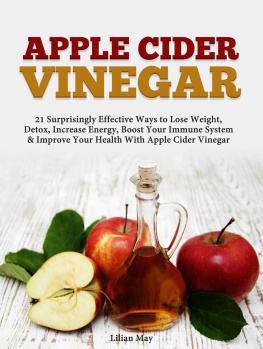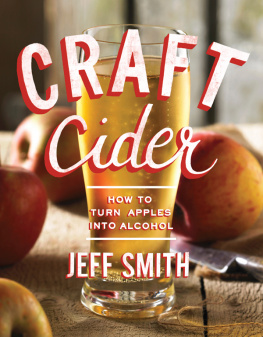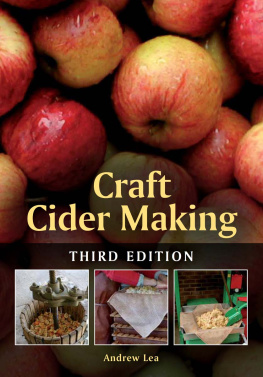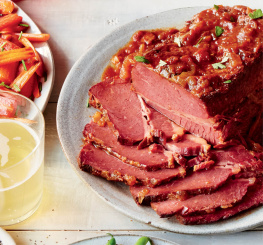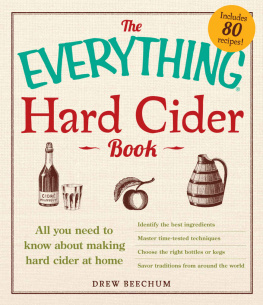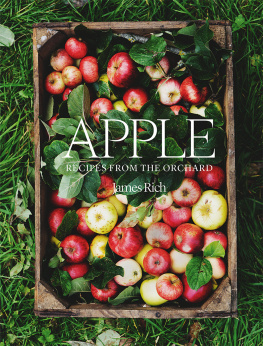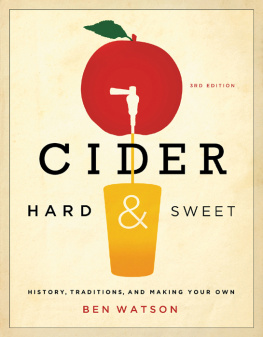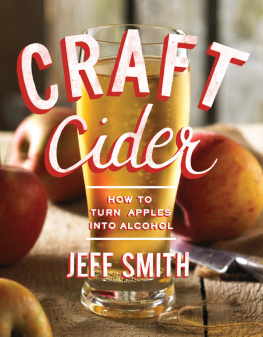Cider
MAKING, USING & ENJOYING SWEET & HARD CIDER
Third Edition
ANNIE PROULX & LEW NICHOLS

DEDICATED TO CIDER APPLES AND AMATEUR CIDERMAKERS EVERYWHERE
The mission of Storey Publishing is to serve our customers by publishing practical information that encourages personal independence in harmony with the environment.
Edited by Mary Grace Butler and Pamela Lappies
Cover design by Karen Schober, Unleashed Books
Cover illustration by Cyclone Design
Text design by Cindy McFarland
Text production by Eugenie Seidenberg Delaney
Line drawings on pages 5, 6, 17, 140, 141 (top drawing) by Beverly Duncan, and by Judy Elaison on (bottom)
Indexed by Susan Olason, Indexes and Knowledge Maps
Professional assistance by John Vittori, Furnace Brook Winery
Third Edition 2003 by Storey Publishing, LLC
Originally published in 1980 by Garden Way Publishing.
All rights reserved. No part of this book may be reproduced without written permission from the publisher, except by a reviewer who may quote brief passages or reproduce illustrations in a review with appropriate credits; nor may any part of this book be reproduced, stored in a retrieval system, or transmitted in any form or by any means electronic, mechanical, photocopying, recording, or other without written permission from the publisher.
The information in this book is true and complete to the best of our knowledge. All recommendations are made without guarantee on the part of the author or Storey Publishing. The author and publisher disclaim any liability in connection with the use of this information. For additional information please contact Storey Publishing, 210 MASS MoCAWay, North Adams, MA 01247.
Storey books are available for special premium and promotional uses and for customized editions. For further information, please call 1-800-793-9396.
Printed in the United States by Versa Press
10 9 8 7 6
The Library of Congress has cataloged the previous edition as follows:
Library of Congress Cataloging-in-Publication Data
Proulx, Annie.
Cider : making, using & enjoying sweet & hard cider / Annie Proulx & Lew Nichols. 2nd ed.
p. cm.
Rev. ed of: Sweet & hard cider. c 1980.
Includes index.
ISBN 978-1-58017-520-3
1. Cider. 2. Apples. I. Nichols, Lew. II. Proulx, Annie. Sweet & hard cider. III. Title.
TP563.P76 1997
641.26dc21
97-12169
CIP
CONTENTS

5. BEYOND CIDER:
VINEGARS, BRANDY, TASTING, AND COOKING
ACKNOWLEDGMENTS
Scores of people amateur and commercial cidermakers, professional cider researchers, librarians, curators, tax authorities, nutritionists, chemists, pomologists, nurserymen and -women, apple growers, and many others have given us suggestions, explanations, tours, rulings, services, opinions, their time, and an occasional sample of the subject.
Our sincerest thanks go to: R. L. La Belle, Jerome Van Buren, and Roger Way of the N.Y. State Agricultural Experiment Station, Geneva; F. W. Williams of the Long Ashton Research Station, Long Ashton, Bristol, England; J.-F. Drilleau of the Station de recherches cidricole, Le Rheu, France; W. P. Mohr of the Agriculture Canada Smithfield Experimental Farm, Ontario; J. A. Kitson of the Agriculture Canada Research Station, Summerland, B.C.; R. L. Granger of Agriculture Canada Station de recherches, Saint-Jean, Qubec; R. J. Traverse, Newfoundland Dept. of Forestry and Agriculture, St. Johns; C. G. Embree, Nova Scotia Dept. of Agriculture and Marketing, Kentiville; E. N. Estabrooks, New Brunswick Dept. of Agriculture and Rural Development, Fredericton; E. J. Hogue, Canadian Society for Horticultural Science.
Also, F. P. Corey of the International Apple Institute, Washington, D.C.; L. D. Tukey of the Dept. of Horticulture, Pennsylvania State University; R. E. Daugherty, chief, Rulings Branch, U.S. Dept. of the Treasury; Claude Bourgeois and Luc Dsautels of the Socit des Alcools du Qubec; Normand Cormier and Marie-Andre Beaupr of the Bibliothque Nationale du Qubec; the McLennan Library of McGill University, Montreal; library staff at MacDonald College, Ste. Anne de Bellevue, Qubec; Library of the Jardin Botanique, Montreal; Bailey Library at the University of Vermont, Burlington; Ms. I. Peggy Keeton of the Long Ashton Research Station Library, Long Ashton, Bristol, England; the Northeast Regional Library, St. Johnsbury, Vt.; the libraries of the University of Massachusetts, Amherst; Dr. G. S. Carlson of Palo Alto, Ca.; C. D. Osborne of H. P. Bulmer Ltd., Hereford, England; Alain Lecours of La Cidrerie du Qubec, Ltd.; and Ms. Gail Hyde of the Geneva Station Library.
The help of nurserymen and apple growers Lewis Hill of Greensboro, Vt.; K. E. Parr of East Burke, Vt.; Hertel Gagnon of Compton; Paul Gadbois of Rougemont, and Marc Bieler of Frelighsburg, all in Qubec, is also appreciated. And thanks to cidermakers S. Thatcher of Sandford, Somerset, and Robert and Hartley Williams of Backwell, Bristol, England; Maurice Lemoine of Janz, Brittany, France, and Herbert Ogden of Windsor, Vt.
INTRODUCTION
Interest in cidermaking and cider drinking has had an explosive resurgence in this country in recent years. Hard cider is the fastest-growing segment of the liquor industry, riding on the coattails of the microbrew surge, and is considered by many to be the drink of the future. What many people may not know is that cider, both sweet and hard, was the drink of Americas past.
Cider drinking has been an American tradition since the days of the Mayflower, whose passengers brought it with them from Europe. By 1638, barrels of cider could be found in the cellars of virtually every farmhouse and city home in New England. Cider, truly the outstanding American beverage, was regularly enjoyed by many notable historical figures. John Adams, second president of the United States, drank a tankard of cider every morning before breakfast, and lived to the age of 91. In 1840, the Whig Party nominated William Henry Harrison as its candidate for president, and the campaign symbol was a barrel of cider. This Cider Campaign, in which the Whigs served free cider to all who could or would vote, brought Harrison to a landslide victory. Obviously, the voters knew the true meaning of the American spirit! Between 1870 and 1892, cider consumption rose a healthy 200 percent to become the most popular drink in America.
Early in the twentieth century, poet Robert Frost wrote In A Glass of Cider, a loving tribute to the effects of drinking cider. And on hot African nights, while on rugged lion safaris, Ernest Hemingways favorite drink was you guessed it cider.
The cultural phenomenon in the United States during the late 1980s and early 1990s of home brewing and microbrew beers has enticed the American palate to try varied styles of old-time recipes. The relative ease with which one can make cider has contributed to this growing popularity. Although there are technical aspects and personal preferences involved, essentially all you need is the apple nothing added, nothing taken away to make a delicious sweet cider that when allowed to ferment will create a sparkling hard cider that rivals the finest of champagnes.
Until about 1990 there were very few domestic ciders commercially available. For the most part, the only imported ciders available commercially in the United States were from the United Kingdom and France, two regions that have been producing cider for many centuries. The current cider market consists of dozens of commercially produced domestic ciders, and more are popping up every day. The styles and methods of production today are as numerous as the apple varieties themselves. The leading national cider brands are made primarily from apple concentrates and flavorings. They are marketed in six packs to a customer who prefers a sweet bubbly cider thats about six percent alcohol. Ciders produced by hard cider artisans, in contrast, are made with apples grown at home and crafted in small batches in oak barrels. These ciders, for the most part, are sold regionally and can be much drier and higher in alcohol. Whichever your preference, judge each cider on its own merits.


